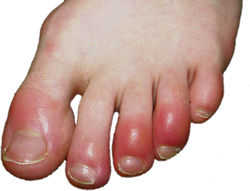What is a Chilblain
This is a seasonal, sudden constriction of a blood vessel affecting the young and old. This cold injury, when resolving may be mistaken for unusual hard skin or old blisters. There may be an underlying medical condition complicating the problem.
What do chilblains look like?
Chilblains occur most commonly in the winter and are about 2cm in diameter, are usually discoloured and may itch or be painful. They affect the extremities, feet, hands, ears and nose. The discolouration changes according to the stage of the chilblain. Initially the area of cold damage is white due to constriction (closing) of the blood vessels. Later, when the blood vessel eventually dilates (opens) and consequent tissue damage occurs, the site shows a bright red inflammatory reaction. A few hours later the site becomes swollen and bluish from prolonged dilation of the blood vessels. As the lesions resolve over days to weeks, the skin may wrinkle, look shiny and scale. If the chilblain site is damaged then the area may become broken and take some weeks to heal.
Management of chilblains
Management requires minimising exposure to extremes of temperature and rapid temperature change e.g. avoid walking in bare feet on cold floors and then sticking your feet in front of a fire to warm them up. Insulating footwear may need to be a size bigger than normal; adding insulating materials to footwear also requires sufficient space, otherwise the tissues will be constricted, depriving them of local blood flow which will make the situation worse.
Topical preparations can be applied according to the stage of the chilblain; a cooling, soothing preparation can be used to control the red inflammatory stage e.g. witch hazel. In the swollen, bluish stage homeopathic and herbal preparations such as calendula and peppermint oil can help with very gentle, superficial massage, but not if the skin is broken.
Proprietary chilblain creams that contain active ingredients such as methyl salicylate and capsaicin are aimed at dealing with chilblains in all their stages. At Howlett & Dickinson we supply Akilwinter Cream for hands and feet chilblain & frostbite prevention.
Howlett & Dickinson use Low Level Laser Therapy which also helps to stimulate healing and circulation.
We can now offer Warm Wax Therapy which is beneficial in the treatment of chilblains, as it increases blood flow, tolerance for pain, relaxes muscles and increases skin hydration.
Over areas of pressure which could result in the skin breaking open, the podiatrist can apply deflective padding to aid healing.
Patients with poor circulation need to be monitored carefully to avoid breaking of skin and secondary infection.
Regular exercise can improve circulation and reduce the risk of developing chilblains. Stopping smoking will also improve circulation, reducing the risk of chilblains.




